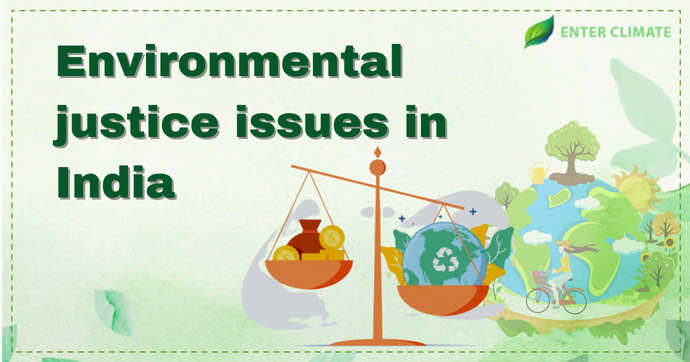Environmental justice issues in India
 19 Jan, 2023
19 Jan, 2023 
According to the Environment Protection Agency, environmental justice is the “fair treatment and meaningful involvement of all people regardless of colour, race, nationality, or income with respect to the development, enforcement and implementation of environmental laws, regulations and policies”.Understanding what constitutes an environmental justice issue in India will first need an understanding of the prevailing social disparities and environment-related problems that India is facing today.
The neoteric ecosystem we live in today has been built on the pillars of industrialisation and technology. Economic development has, on the one hand, raised the living standards for many, but on the other hand, it has also given rise to some problems, such as the uncontrolled exploitation of natural resources and the pollution caused by the unchecked discharge of waste from households and industries. Our focus on the developmental aspect led to the exploitation of nature and our surrounding environment, bringing many natural ecosystems to the brink of collapse. The environmental justice issues in India are not limited to pollution and climate change but are much more complex. In this article, we will discuss what led to these changes and the issues related to environmental justice in the country.
Environment Justice Movements in India
Environmental justice began in many countries after its origin as a concept during the Civil Rights movement in the US. It slowly picked up momentum in many countries, including India. Environment justice issues were present in India for a long time but needed to garner more attention as they remained localised to a particular region. But as the social justice movements grew wider along with environmental issues, they began getting public support. The well-known Chipko movement was one of the most popular efforts to bring the environment to the centre of India’s conscientiousness. Since then, many famous and not-so-popular but equally crucial struggles have been fought by different groups demanding the right and inherent access to natural assets such as land forests, water bodies etc. A nationwide push for environmental justice movements came at the time of the Bhopal Gas Disaster of 1984. This man-made disaster resulted in activism and mobilisation around environmental issues concerning industrial policies and related legislation.
Many pieces of legislation in India passed with the advent of modern forestry and wildlife preservation purposes diminished the local control of natural resources by those directly dependent on them. The conflict created by the state’s development activities at the cost of nature brought in a wave of environmental justice movements in the country, such as the Narmada Bachao Andolan[1] or the Appiko movement or the Silent Valley protest.
Major Environmental Justice Issues
Environmental issues are seen in areas slowly destroying the environment and natural habitat, degrading the natural balance of the ecosystems like forests, water bodies, etc. This has often led to public outrage in many forms, such as direct violence, structural and cultural violence, slow violence and ecological violence.
As per the EJAtlasdatabase (2018), more than 85% of the legal cases related to the environment in the country are either high-intensity cases that include widespread mass mobilisation and violence or medium-intensity cases that have visible mobilisations like street protests, rallies etc. The low and latent intensity cases are still brewing and have no visible organisation, and are comparatively fewer in number. Of the 125 high-intensity cases, 92 falls into just four categories: fossil fuels and climate change (26), water management (28), mineral ores and building extraction (18) and industrial and utilities conflicts (20).
Conclusion
Many communities and groups of social scientists and even technical professionals have been advocating for the rights of healthy living for the underprivileged communities of the population, such as forest dwellers and tribal communities. India’s image as a progressive jurisdiction in environmental matters through its proactive judiciary is now being internationally recognised. The National Green Tribunal of India, or the NGT, plays a vital role as a ‘specialised body equipped with the expertise to handle environmental disputes in this regard. It has remarkably handled cases involving multi-disciplinary issues, provide justice to the aggrieved, and offered greater plurality to environmental justice movements in the country. Today, many parts of the country face water scarcity and abrupt weather patterns. We have learned to live in what is considered one of the most polluted conditions anywhere. Therefore, a system that protects the rights of healthy living conditions is essential for India, and an audience should be given to those suffering due to these environmental issues.












